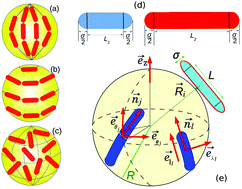Length segregation in mixtures of spherocylinders induced by imposed topological defects
Abstract
We explore length segregation in binary mixtures of spherocylinders of lengths L1 and L2 which are tangentially confined on a spherical surface of radius R. The orientation of the spherocylinders is constrained along an externally imposed direction field on the sphere which is either along the longitude or the latitude lines of the sphere. In both situations, integer orientational defects at the poles are imposed. Using computer simulations we show that these topological defects induce a complex segregation picture also depending on the length ratio factor γ = L2/L1 and the total packing fraction η of the spherocylinders. When the binary mixture is aligned along the longitude lines of the sphere, shorter rods tend to accumulate at the topological defects of the polar caps whereas longer rods occupy the central equatorial area of the spherical surface. In the reverse case of latitude ordering, a new state can emerge where longer rods are predominantly both in the cap and in the equatorial areas and shorter rods are localized in between. As a reference situation, we consider a defect-free situation in the flat plane and do not find any length segregation there at similar γ and η; hence, the segregation is purely induced by the imposed topological defects. We also develop an Onsager-like density functional theory which is capable of predicting length segregation in ordered mixtures. At low density, the results of this theory are in good agreement with the simulation data.



 Please wait while we load your content...
Please wait while we load your content...